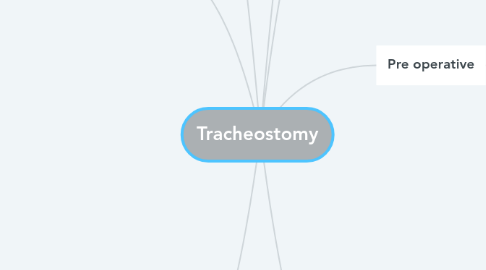
1. Contraindications
1.1. In patients with obstructive carcinoma of the larynx,
1.2. foreign body is lodged below the level of the tracheostomy site
2. Classifications of Tracheotomy
2.1. According to:
2.1.1. Emergency Vs Elective
2.1.2. Surgical Vs Percutaneous
2.1.3. High Vs Mid Vs Low
2.1.3.1. depending on the level at which it is inserted into the trachea
2.1.4. Temporary Vs Permanent
2.2. 1-Surgical
2.2.1. Performed in OR
2.2.2. Technique
2.2.2.1. Incision 1 cm below the cricoid or over the 2nd tracheal ring
2.2.2.2. Blunt dissection of subcutaneous tissue
2.2.2.3. The right and left sides of the trachea are kept open with blunt hooks.
2.2.2.4. Inserting the tracheostomy tube
2.3. 2-percutaneous
2.3.1. Performed in Bedside or ICU
2.3.2. Technique
2.3.2.1. Incision 1 cm below the cricoid or over the 2nd tracheal ring
2.3.2.2. special lens is fed through the mouth
2.3.2.3. The surgeon guides a needle into the trachea to create the tracheostomy hole
2.3.2.4. Then the surgeon inserts the tracheostomy tube through this hole under vision
3. Classifications of tube
3.1. Cuffed
3.1.1. It form a seal with the surrounding tissues of the tracheal wall
3.1.2. prevent aspiration to the lower airway
3.1.3. prevent air leakage in a mechanically ventilated patient
3.2. Cuffless
3.2.1. Indicated If a patient no longer requires a tracheostomy tube with the cuff
3.2.2. Patient in the recovery phase
3.3. Double Lumen
3.3.1. Inner and outer cannula
3.3.2. The inner lumen can be changed/cleaned
3.3.3. reducing the risk of occlusion.
3.4. Single Lumen
3.4.1. Most pediatric tracheostomy tubes
3.4.2. Resistance may be reduced
3.4.3. entire tracheostomy tube would require to be changed
3.5. Fenestrated
3.5.1. allow the patient to phonate and cough
4. operative procedure that creates a surgical airway in the cervical trachea
5. Indications
5.1. breathing machine (ventilator)
5.2. block or narrow your airway,
5.2.1. vocal cord paralysis or throat cancer
5.3. conditions that make it difficult to cough
5.3.1. require direct suctioning of the trachea to clear your airway
5.4. Preparation for major head or neck surgery
5.5. Severe trauma
5.6. physician can’t intubate the patient.
6. Pre operative
6.1. History
6.2. Physical examination
6.3. Consent
6.4. CBC
6.5. Anesthesiologca assessment
6.6. Coagulation profile
6.6.1. By laboratory evaluation
6.6.2. Platelets count markers
6.6.2.1. Prothrombin time
6.6.2.2. International normlized ratio(INR)
6.6.2.3. Partial thromboplastin
6.7. Adequate light
6.8. Trachesotomy set
7. Post management
7.1. Chest X-Ray
7.2. Strong analgesia
7.3. Antibiotics
7.4. Constant supervision for any bleeding or block
7.5. Suctioning
7.6. Complications
7.6.1. Immediate
7.6.1.1. Bleeding
7.6.1.2. Malpostion tube
7.6.1.3. Respiratory function
7.6.2. Delayed
7.6.2.1. Tube blockage/displacement
7.6.2.2. Infection/ulcer
7.6.2.3. Bleeding due to tube erosion
7.6.3. Late
7.6.3.1. Scar
7.6.3.2. Granulation
7.6.3.3. Tracheal stenosis
